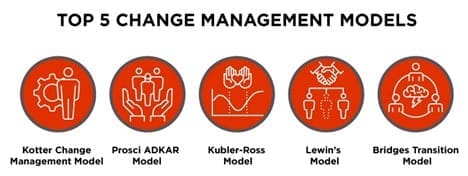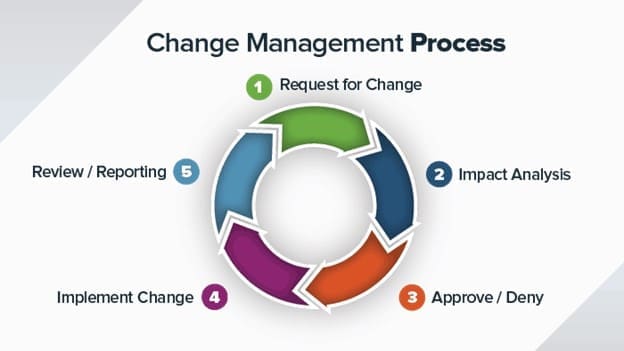Table of contents
What is Change Management?
Over the past quarter-century, change management has matured and evolved as a discipline. Prosci’s research shows that for changes to succeed, it is essential that we prepare, empower, and support people as they move through the changes. Changes will fail if people don’t adopt them. We won’t achieve the desired results.
Management of change draws upon theories from many disciplines including psychology, engineering, and systems thinking. There are many models available. Theories on change management agree that change cannot be achieved in isolation. Change impacts all employees and the entire organization in some way. However, with effective change management, everyone can adapt and embrace the new way of working.
Communications are not particularly important
The change management process consists of a communication plan in which executive leaders and project managers inform the organization about any changes that are imminent (usually at short notice). The change management process goes beyond simply communicating what is evolving. This could be system implementation or even an acquisition.
Supporting people in an organization during their transitions to the future state is essential. We also need to understand how to get each person to accept and embrace change. This will increase the likelihood of projects succeeding and project investments being successful.
A structured and flexible approach is essential.
Depending on their business needs, organizations may adopt the discipline of the change management process in a variety of ways. They might have a critical technology implementation that is required to benefit from change management. Or they may decide to invest in change management as an organizational capability to help support business growth. This means that change management is flexible in its scope and purpose. Each organization may define it and implement it differently.
Companies must have a flexible and structured approach to managing organizational change.
Why change management?
Your ability to manage change has a direct impact on the things that are most important to you, including your customers, employees, and profitability. The reasons to manage change are increasing as organizations face more complex and faster changes than ever before. Change management is more than just preparing, equipping, and supporting employees to adopt, use, and successfully manage change.

Change Management Principles
Four core principles are the cornerstones of successful change management:
- Understanding Change
- Plan Change.
- Make Change.
- Communicate Change
Understanding Change
You must understand the benefits of change to promote them successfully. Think about the following:
- What are the organizational benefits of this change?
- What are the steps people must take to make this change happen?
- What will this mean for the way people work?
- What you should do to make a difference. What are your main objectives?
- What will this do for people?
It is also helpful to consider the negative consequences of certain actions. Not Making the change would be. Beckhard and Harris’ Change Equation. For change to succeed, there must be enough dissatisfaction with the current way of doing things. People must also feel that the innovative approach is better and that there is a straightforward way to get there.
Plan Change
It is not possible to make effective change happen by chance. Any plan that you create must be tailored for your company. Each organization’s approach to managing change projects will be different. Some organizations have rigid change processes, while others are more flexible and open to change.
You should consider the following:
- Buy-in. You can only make positive changes when you’re able to support your team from all levels of the company. What are your plans to accomplish this?
- Impact. Think about what success looks like. How can you determine the impact of the changes you are trying to make and how do you assess it? What are your goals?
- Involvement & participation. Will you require external expertise? Or can you make use of your own resources?
- Sponsorship. What can you do to secure, engage, and use high-level sponsorship and support for the change?
Implement Change
How can you make positive changes?
There are many ways to implement your changes, as we have seen. Kotter’s 8 Step Change Model explains how you can infuse urgency into your actions to build momentum and inspire others to follow your lead.
No matter what tools you use, these steps will help you implement positive change.
- Recognize any training requirements that need to be met for the change to be implemented.
- Agree on the success criteria for your changes, make sure they are regularly measured and reported.
- Make sure everyone involved understands the implications of the changes.
- Identify all key stakeholders involved in the change by mapping them and defining their involvement.
- Designate “change agents” to help implement the new practices and be role models.
- Be sure everyone is supported throughout the entire process of change.
- There are many ways to change people’s habits so that new practices are the norm.
Communicate Change
Communication is a key component in the change management process. You must make sure that the change you are trying to implement is clear and pertinent so that people can understand why it is important. You must also set the right tone to get the desired emotional response.
It is a smart idea to connect the changes you are planning to your company. Vision statements or mission statements. This will help people see how positive change affects the “bigger picture” and will provide them with an inspiring, common vision for the future.
Make sure you practice good habits. stakeholder management. This will help you to send the right message at the right time to the right people for you to get the support you need.

The ADKAR Change-Management Model
This is an especially useful tool to communicate your changes. These are five points you need to address in your change management ADKAR communications.
- Awareness (of changing things).
- Want (to take part in and support it).
- Knowledge (of what to do)
- Ability (to change).
- Reinforcement (to maintain the change over the long-term).
What can prevent change?
You should be prepared for any setbacks. You might be criticized by others for being pessimistic about the plans you have. If this happens, acknowledge it, understand it, and address it. Resistance or “immunity to change”.
It is possible to even be up against cultural barriers, change is possible. You must encourage change in your organization’s culture if it doesn’t embrace it or pushes against change.
Which management style is best for change management?
There is no one-size-fits-all approach to the change management process. Therefore, there are many ways to manage it.
It’s important to be authentic and to lead in the way that is right for you. Flexibility and adaptation are possible to adapt your approach to meet the specific challenges your organization faces and the behaviors you want to change.
Characteristics of successful change leaders:
- Ability to think strategically and connect the change to the larger picture.
- Emotional intelligence: recognize the personal struggles people face with change and resist resistance to it.
- The ability to form coalitions Inspire trust.
- At every stage, you need to have effective communication skills.
Core principles of change management
- Understanding Change: For change to be successful, it is important to fully understand the details of the change. It will explain what it is, how it will happen, and why.
- Plan for Change: This can include high-level sponsorship and identifying more involvement and buy-in opportunities.
- Implement Change Before you start to implement your plan, make sure everyone is aware of what you’re doing. This could include addressing training issues, appointing change agents, providing support for employees across the organization and setting success criteria.
- Communicate Change Everyone needs to understand why change is occurring, how to feel good about it, and how they can make it a success.












